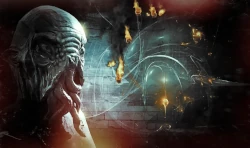Mexico 1886. A UFO photo?
On August 12, 1883, astronomer Jose Bonilla reported that during observations of the Sun at the Zacatex Observatory in Mexico, he registered more than 300 dark unknown objects crossing the solar disk of the Sun.He managed to take several photos of the observed phenomenon with an exposure of 1/100 of a second.
It was claimed that the objects taken were birds flying at high altitude, but Bonilla himself believed that he had managed to photograph unidentified flying objects for the first time. In 2011, researchers from the National Autonomous University of Mexico suggested that unidentified objects may have been fragments of a collapsed comet passing within a few hundred kilometers from Earth.
On August 12 and 13, 1883, Jose Bonilla noticed blurry objects surrounded by a light haze against the background of the Sun. In two days he managed to count 447 similar objects. Bonilla published his picture three years later — on January 1, 1886 in the astronomical journal L'Astronomie. In his article, however, he did not offer any explanation for the observed phenomenon.
During 40 minutes of this period, 48 new objects were observed. Their trajectories indicate movement from west to east, more or less inclined to the north and south of the solar disk. Some of these objects looked black and perfectly round, others were more or less elongated
Here's what he wrote:
The assessment showed that some debris flew only 538 kilometers from the surface, others 8062 kilometers. They were up to 795 meters wide and more than a kilometer long.
I remind you: these are objects that have passed against the background of the solar disk. How many were there in TOTAL?

Whether to trust this information should be decided by the reader himself. My task is to fix the fact of the existence of this story and objectively submit it. More reliable data are contained in the original astronomical journal in the original language. At the same time, when collecting material for this article, I drew attention to the frequent cases of detection of strange activity in space in the middle of the 19th century. One way or another, the conclusion will have to be made.
Versions of the "Jose Parade":
- Comet version. A cloud of fragments of a comet body with a front of 10,000 km invaded the Solar System. Passing by the Earth, the edge of the cloud caught our planet. Thousands of fragments of different sizes crashed into the lithosphere, exploding at the surface, provoking earthquakes and tsunamis. At the same time, the atmosphere loses a significant part of its gas volume and oxygen is burned out.This hypothesis explains many of the phenomena that we observe today. The only drawback of it is how miraculously the inhabitants of the planet Earth managed to survive.
- A version of the intervention of alien forces. The objects captured in the photo are space cars and cargo transport. What are they doing in near-Earth space? I think that you can't expect anything good from such an armada! But this is an area of ufology in which I am not strong.
- Combined version. When a large comet approached the Earth, space observers were mobilized. As a result of the preemptive strike, the comet was shattered into many fragments. Thus, the camera captures the passage of the remaining fragments and their accompanying fireballs. Large fragments threatening the Earth were destroyed near the surface. However, a trifle in an uncritical volume fell on the planet, causing local cataclysms. This hypothesis is more universal, although less realistic at first glance. I like her better.
- Early Starlink. We have already written about the fact that satellites similar to Starlink were observed long before the birth of Elon Musk himself. In this case, there is a place to be something similar only in the 19th century. The presence of trajectories in your applications does not necessarily mean launching them from the Ground, but for example, it can talk about calculating the trajectories of existing objects.
The Mexican National Astronomical Observatory is an astronomical observatory founded in 1878 in Mexico. The observatory was created and belongs to the National Autonomous University of Mexico. The observatory was installed in 1878 on the balcony of the Chapultepec Palace in Mexico City. Later, the observatory moved to the outskirts of the city in the Tacubaya district. In the middle of the XX century, the observatory was moved to Tonantzintla, Puebla. And in 1967, the observatory was finally moved in the north of Mexico to the area of San Pedro Martir, Baja California.
About author:
Serg Toporkov Ufologist, Ph.D., blogger, I go on my own expeditions for UFOs. I use scientific methods to investigate the UAP phenomenon. Write to me |
Related tags:
José Bonilla Mexico UFO UFO sightings 1886 UFO photo Starlink Elon MuskRandom UFO or conspiracy article
Reptiloids against humanity
 Attention, this information is provided to you in order to familiarize yourself with the existing theory, it may be false. We do not encourage you to do anything, and if you do not accept this, leave the page
Attention, this information is provided to you in order to familiarize yourself with the existing theory, it may be false. We do not encourage you to do anything, and if you do not accept this, leave the page
